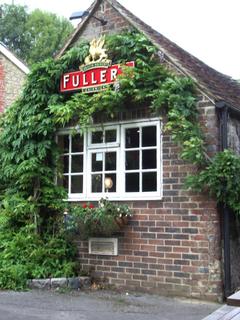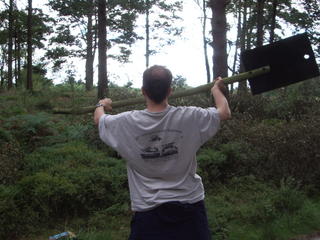Growing up in Tennessee you get spoiled by the wonderful parks and recreation areas we have with thousands of great hikes on public lands, many through wilderness areas. In England there’s really no such thing as a wilderness area as we know it in America, and there are certainly no virgin forests that I’m aware of. Nearly all of the countryside is managed in some way and almost everywhere has been continuously inhabited, even if by a scant population and their sheep.
But the English like it that way, and part of the ‘farm movement’ is to protect the managed countryside. It certainly is beautiful. And despite the lack of vast tracts of public lands, there are still plenty of areas, even in the densely populated South East of England where you can go walking over hill and down dale with at least a tree line between you and the nearest housing development. This is because England has a tradition of the commons and freedoms to walk ancient footpaths or rights-of-way across privately owned land. There’s even a group which actively promotes keeping the footpaths open and in common use, the Ramblers’ Association. This means you don’t have to ask permission to walk a footpath and the landowner is under obligation to keep the path free of obstruction. Landowners and the Ramblers occasionally get into it, even Madonna has had some trouble over the whole footpath issue.
You can get ordinance survey maps which indicate the public footpaths, but me and the Vol-in-Law tend to use guide books with walks already planned out, usually with a very nice pub at the halfway point. Our favourite book is the Time Out Guide to Country Walks near London, and with these you can even use public transportation to get you to the start and finish of the walk. Yesterday though, we drove down to the quaint commuter village of Haslemere. Driving means you’re not at the mercies of the railways and train delays, but it also means that you risk being stuck in heavy Greater London traffic. Which is just what happened to us.
We started quite late in the day anyway, so we didn’t actually start walking until about 2pm. In winter this would mean we’d have about an hour before it started getting dark, but it’s still light quite late into the evening, so we were OK. It was roughly a 9 mile hike, but it felt much longer, because some of the paths were quite steep and quite deep in sucking clay as a result of the high precipitation we’ve been having recently.

Because we started so late, the halfway pub wasn’t serving food, but we did have a pint of the local bitter. It was a lovely traditional pub, but the gal behind the bar, a very attractive blonde, was in a sour mood. It didn’t so much seem like she was having a bad day, but more a permanent chip on the shoulder.
We discussed her non-customer-friendly attitude after leaving the pub.
Vol-Abroad: She seemed like maybe life didn’t turn out quite like she planned. Like maybe all that promise of attractiveness didn’t quite pay off and now she’s stuck behind a bar.
Vol-in-Law: Like maybe she ended up with the wrong sort of chap.
VA: Exactly,
ViL: It’s often the really pretty ones that end up with the wrong sort of chap. The wrong sort of chap is the kind of guy who’s a chancer, who plays the numbers game, trying it on with everyone just to see who’ll bite. Whereas, a nice chap might be put off by very attractive features, thinking he wouldn’t have a chance, so wouldn’t approach her to begin with.
VA: But not you.
ViL: There’s just no right answer to that one, is there?
 Part of the walk led us through heathland, with lovely summer-blooming heather and thickets of blueberries and beautiful views across the South Downs. And other parts of the walk led us through brambles heavily laden with blackberries. Although I pride myself in having a not insignificant amount of horticultural knowledge, there’s always a part of me which doubts the wisdom of foraging berries in the countryside not in my native land. I know it looks like a blueberry plant in form and foliage, and those berries look and taste like blueberries, but perhaps it’s really the unique English pseudo-blueberry, which leads to a horrible death (if you eat a lot) or unpleasant stomach ailments (if you eat just a few). Or maybe I was just suffering the effects of the pseudo-blackberries I ate earlier which bring on symptoms of self-doubt and paranoia.
Part of the walk led us through heathland, with lovely summer-blooming heather and thickets of blueberries and beautiful views across the South Downs. And other parts of the walk led us through brambles heavily laden with blackberries. Although I pride myself in having a not insignificant amount of horticultural knowledge, there’s always a part of me which doubts the wisdom of foraging berries in the countryside not in my native land. I know it looks like a blueberry plant in form and foliage, and those berries look and taste like blueberries, but perhaps it’s really the unique English pseudo-blueberry, which leads to a horrible death (if you eat a lot) or unpleasant stomach ailments (if you eat just a few). Or maybe I was just suffering the effects of the pseudo-blackberries I ate earlier which bring on symptoms of self-doubt and paranoia.I digress
I’m sure I can trace this phobia to a childhood episode in which my mom caught me eating some berries that I had picked and collected in a handkerchief. I remember her shock and horror at seeing me eating these berries. Neither of my parents recognised these berries, we were living in upstate New York at the time and my parents had grown up in Tennessee where these berries didn’t grow (my mom has pretty good horticultural knowledge and plant ID herself). I remember telling her that a ‘grown-up’ had told me it was OK to eat them, but I don’t actually remember a grown-up imparting this knowledge, so I can’t be sure that that really happened. I was an only child at that point, I was only three or four, and my parents were perhaps a little over-protective. Anyway, I definitely remember they made me drink some Syrup of Ipecac which produced the usual violent vomiting reaction, which I also remember. My parents later found out that these berries were perfectly safe to eat, but I’ve stayed away from currants ever since.
Back to the story

Anyway, that’s about it, except for one mystery. A couple of places along the walk, poles had been erected upon which were hung rubber paddles with long wooden handles. I can’t imagine what these were for, unless they are for beating grouse out of the heather and brush during grouse hunting season. Here’s a picture of the Vol-in-Law wearing a Tennessee Army National Guard 278th Armored Cavalry t-shirt holding up one of these paddles. If you have any idea what these are for, answers on a postcard (or the comments section), please.
No comments:
Post a Comment